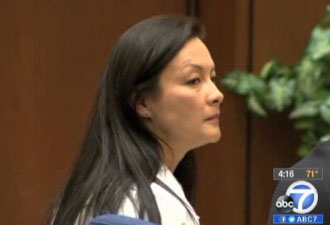A beautiful model and actress was strangled to death over five years ago by the half-Korean Camarillo resident Kelly Soo Park, according to the case prosecutors will lay out in a murder trial that opened Wednesday in downtown Los Angeles.
The huge amount of publicity the case has received since Redding was murdered on March 15, 2008 is due largely to the fact that she was gorgeous enough to have been featured on the cover of Maxim, and had had a small role in the indie movie Kathy T. The publicity also has much to do with the fact that the case against Park, 47, includes some sensational aspects.
Park’s only alleged motive for killing Juliana Redding is the large sums of money paid her by a shady orthopedic surgeon who called Park his “James Bond”. The prosecution is seeking to make the case that Park was Dr Munir Uwaydah’s enforcer and killed Redding five days after Redding’s pharmacist father pulled out of a deal to open a chain of pharmacies together with Uwaydah.
Park is alleged to have essentially used her bare hands to beat and strangle Redding, a fit young woman who had been on her Tucson high school’s track and golf teams before moving to Santa Monica to pursue a career as a actor and model. Forensic evidence leaked to the public before the prosecution sealed all records shows that a fierce struggle took place in Redding’s apartment. The many injuries suffered by Redding includes a broken bone in her neck but no sign that a weapon had been used.
Oddly Uwaydah, who now lives in his native Lebanon, has not been charged or even directly implicated in the murder, though he is believed to be the source of $250,000 paid to Park three weeks before the murder and $113,400 paid to members of her family just before her arrest two years after Redding’s death. He also paid her a monthly salary of $10,000 though what she did for him isn’t clear. The prosecution has been keeping its case close to the vest but early reports have suggested that Park helped Uwaydah collect moneys owed him though she has described herself as his real estate broker. Uwaydah’s connection with Redding apparently began when he dated her briefly, though their relationship had ended months before her death.
Another odd aspect of the case is that Park’s Camarillo roommate, a beefy 37-year-old named Ronnie Wayne Case, wasn’t charged though he had been arrested with Park in 2010.
Park is placed at the scene of Redding’s murder by drops of blood and DNA, including on Redding’s neck.
Park’s defense attorney has tried and failed to get Judge Kathleen Kennedy to let him present in his opening statement the possibility that Redding was murdered by her tattooed surfer boyfriend John Gillmore. Gillmore had called the police to Redding’s apartment after he and her parents weren’t able to reach her by phone. The police had spotted drops of blood on the sidewalk in front of Redding’s apartment, persuading them to enter it.
The defense is seeking to have Gillmore considered an alternate suspect based on an argument he had with Redding on the night of her death as documented by their text messages. However, the argument ended with her inviting him over to watch Seinfeld. Gillmore also has a history of domestic violence. But Santa Monica detectives ruled him out as a suspect based on a sound alibi and the fact that his body showed no signs of the kind of physical struggle suggested by Redding’s bruised body and broken fingernails.
The defense also turned to an audio enhancement expert who claimed that the audio of a videotape of Gillmore while left alone in the interrogation room contained a confession. He claims that the enhanced audio shows the distraught Gillmore saying, “Yes. I found you with someone,” and, “I did it.”
Judge Kennedy listened to the enhanced audio during an in-chambers motion and agreed with the prosecution that it sounded like “gibberish”. She therefore denied the defense motion to be allowed to point the finger at Gillmore during its opening statement. She did leave open the possibility that evidence relating to the argument may be introduced later in the trial.


